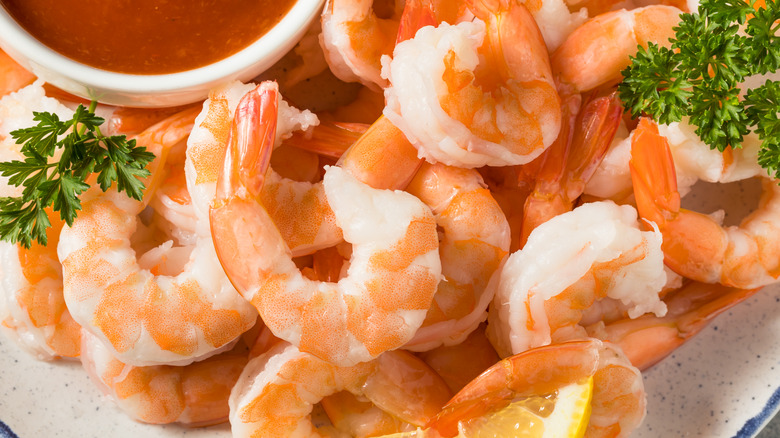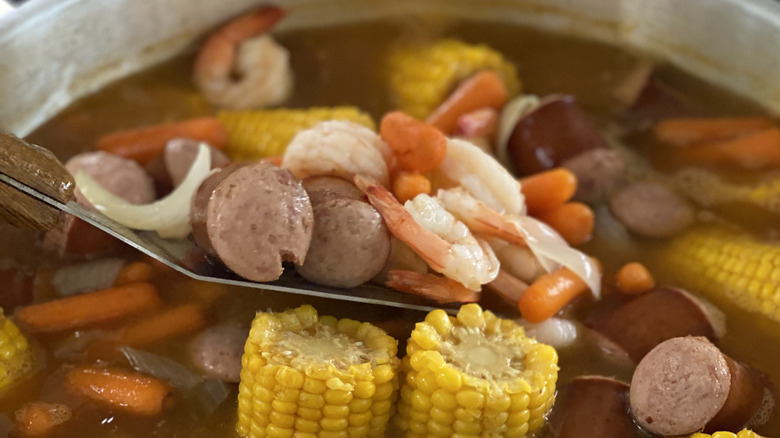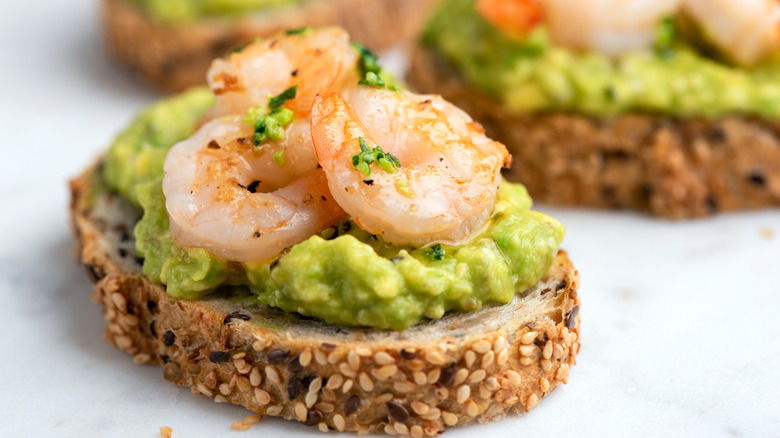Take Your Poached Shrimp To The Next Level By Flavoring The Liquid
Shrimp is one of America's most often consumed types of seafood. Not only can shrimp be more affordable than some other seafood options, but it's also a key ingredient used in cuisines across the globe. Its versatility ranges from a barely cooked shrimp ceviche from Peru to butter-drenched potted shrimp from Britain, or flash-fried, in the shell, salt and pepper shrimp from China. Shrimp is a perfect seafood option for land-locked kitchens because most shrimp has been frozen before arriving in stores.
Of course, if you are close to the coasts along the Gulf of Mexico or up the Atlantic Coast to the Carolinas, fresh shrimp is worth seeking out. Poaching is a great way to prepare fresh-caught shrimp so you can enjoy both the sweet flavor and satisfying bite of well-cooked shrimp. Cooking fresh shrimp unpeeled is another key to a proper poach, as the shells contain a lot of flavor. Another key to poaching is imparting lots of extra flavor into your liquid.
How to flavor poaching liquid for shrimp
A New Orleans shrimp boil is one tried-and-true way to highlight this ingredient. Before the shrimp are added, the water gets seasoned with citrus, spices, vegetables, and potent liquid shrimp and crab boil seasoning. This highly-concentrated seasoning liquid lends flavor to the shrimp without being overpowering, which allows the natural seafood flavors to meld with other ingredients.
Even if you're not undertaking a proper shrimp boil, this technique can still be applied to poached shrimp. The basics of poaching shrimp include adding aromatics to boiling water to impart extra flavor to the shrimp as it cooks. Try using ingredients like fresh herbs, onions, and garlic, or substitute some of the water for white wine. In classical French cooking, the flavorful broth made using this method is called court bouillon.
Poaching happens at a low temperature that never exceeds 190 degrees Fahrenheit. Per the FDA, you should also ensure the shrimp have reached a minimum internal temperature of 145 degrees Fahrenheit before serving. If you are making a recipe that requires cold poached shrimp, like a shrimp cocktail, have an ice bath ready. This will stop the cooking at the correct temperature, keeping them from continuing to cook once removed from the heat.
What to do with poached shrimp
Now that you have perfectly cooked shrimp, you have some tasty decisions to make. A shrimp cocktail is an obvious choice for pleasing a crowd. If you've never made cocktail sauce, it can be as simple as simply seasoning ketchup with horseradish, Worcestershire sauce, lemon juice, and a dash of hot sauce.
Poached shrimp can be used as the primary fish in homemade sushi rolls. Vietnamese spring rolls with shrimp are a simple-to-make recipe that makes a big impression, or you can try using poached shrimp in shrimp tacos. Another cold dish, shrimp salad, is tasty enough when eaten on its own, but if you nestle it into a warm, buttered bun, you've got all the makings for a classic shrimp roll.
While there are seemingly limitless applications for poached shrimp, we think there might not be a more flavorful "liquid" to poach shrimp in than gumbo. Shrimp and andouille sausage gumbo is an endeavor that involves dozens of ingredients — and many steps. But, by the time the shrimp are added, the gumbo has been flavored with vegetables, chicken, andouille sausage, roux, spices, and herbs. Even in more simplified versions of shrimp gumbo, the poaching liquid's flavor is just as satisfying as the shrimp. What's better than a poaching liquid you can eat?


